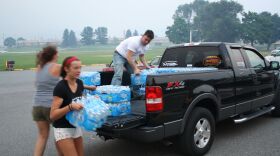Wildfires in the West are getting bigger, hotter – and more costly. A new report from a national science advocacy group says climate change is one major reason wildfires are getting worse. And short-sighted development policies are a big reason they’re costing more.
In recent years, the number of homes and businesses built in wildfire-prone areas has skyrocketed. According to the Union of Concerned Scientists, across 13 Western states there are more than 1-point-2 million homes -- with a combined value of about one-hundred-90 (b)billion dollars -- that are at high or very high risk of wildfires. More than 7 percent of the homes in Oregon are in those areas. At the same time, the cost of battling wildfires has increased nearly four-fold since 19-85. The U-S Department of the Interior expects to spend upwards of 1-point-8 (b)billion dollars on firefighting this year alone. And Rachel Cleetus, an economist with the Union of Concerned Scientists, says that doesn’t even count the costs of other fire impacts.
Rachel Cleetus: “They include damage to property, pollution of watersheds, loss of livelihoods, impacts on public health and an increase in the risk of post-fire flooding.”
Many of those costs, Cleetus says, are the result of what she calls “a misalignment of incentives.”
Rachel Cleetus: “A lot of the firefighting money is coming from federal sources like the Department of the Interior and the Forest Service, whereas a lot of decisions around development are being made at the local level through local zoning regulations, for example, where the folks who make those decisions are not paying for the firefighting cost.”
Ray Rasker is the executive director of Headwaters Economics, an independent research group based in Bozeman, Montana. He applauds the efforts being put into FireWise and other programs to make existing homes safer and more resistant to fire in what’s called the “Wildland/Urban Interface”.
Ray Rasker: “That’s the right thing to do; voluntary landowner education, getting people to create defensible space, using the right building materials. But the conversation also needs to be about the 84 percent of the Wildland/Urban Interface that’s not yet developed.”
Rasker says changing the “pace, pattern and scale” of development in wildfire-prone areas is one way to rein in the costs of fighting and recovering from fires. And he says, making that happen is going require policy-makers to take a carrot and stick approach.
Ray Rasker: “The stick aspect would be for the federal government to bill local governments for their share of the firefighting costs, which would create a strong incentive for better planning.”
Rasker says the carrot could be lowering those costs if the local government shows it’s reduced its wildfire risks … The idea of forcing counties and other local jurisdictions to back their planning decisions with cash is somewhat novel. And, not surprisingly, it isn’t likely to go over well with those local governments. Gil Riddell is the policy director at the Association of Oregon Counties. He says since wildfires usually start on public land, the cost of fire suppression rightly belongs to the federal and state governments.
Gil Riddell: “The largest share of the danger comes from the lands that are producing these fires. And I think you go to the source to deal with that problem.”
Riddell points out that Oregon has strong statewide planning rules, so local governments aren’t the only decision-makers. Besides, he says, cash-strapped rural county governments are in no position contribute to fire-fighting costs
Gil Riddell: “If you’ve been reading the news about the crisis in public safety and mental health, that goes back, for a large part, to meager county budgets.”
Meanwhile, wildfires continue to burn across the region, as the debate over what can be done – and how to pay for it – heats up.
Copyright 2014 JPR.





